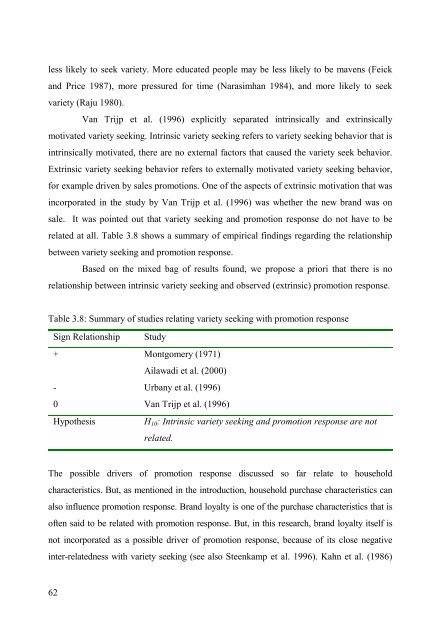Analysis of Sales Promotion Effects on Household Purchase Behavior
Analysis of Sales Promotion Effects on Household Purchase Behavior
Analysis of Sales Promotion Effects on Household Purchase Behavior
Create successful ePaper yourself
Turn your PDF publications into a flip-book with our unique Google optimized e-Paper software.
less likely to seek variety. More educated people may be less likely to be mavens (Feick<br />
and Price 1987), more pressured for time (Narasimhan 1984), and more likely to seek<br />
variety (Raju 1980).<br />
Van Trijp et al. (1996) explicitly separated intrinsically and extrinsically<br />
motivated variety seeking. Intrinsic variety seeking refers to variety seeking behavior that is<br />
intrinsically motivated, there are no external factors that caused the variety seek behavior.<br />
Extrinsic variety seeking behavior refers to externally motivated variety seeking behavior,<br />
for example driven by sales promoti<strong>on</strong>s. One <str<strong>on</strong>g>of</str<strong>on</strong>g> the aspects <str<strong>on</strong>g>of</str<strong>on</strong>g> extrinsic motivati<strong>on</strong> that was<br />
incorporated in the study by Van Trijp et al. (1996) was whether the new brand was <strong>on</strong><br />
sale. It was pointed out that variety seeking and promoti<strong>on</strong> resp<strong>on</strong>se do not have to be<br />
related at all. Table 3.8 shows a summary <str<strong>on</strong>g>of</str<strong>on</strong>g> empirical findings regarding the relati<strong>on</strong>ship<br />
between variety seeking and promoti<strong>on</strong> resp<strong>on</strong>se.<br />
Based <strong>on</strong> the mixed bag <str<strong>on</strong>g>of</str<strong>on</strong>g> results found, we propose a priori that there is no<br />
relati<strong>on</strong>ship between intrinsic variety seeking and observed (extrinsic) promoti<strong>on</strong> resp<strong>on</strong>se.<br />
Table 3.8: Summary <str<strong>on</strong>g>of</str<strong>on</strong>g> studies relating variety seeking with promoti<strong>on</strong> resp<strong>on</strong>se<br />
62<br />
Sign Relati<strong>on</strong>ship Study<br />
+ M<strong>on</strong>tgomery (1971)<br />
Ailawadi et al. (2000)<br />
-<br />
Urbany et al. (1996)<br />
0<br />
Van Trijp et al. (1996)<br />
Hypothesis H10: Intrinsic variety seeking and promoti<strong>on</strong> resp<strong>on</strong>se are not<br />
related.<br />
The possible drivers <str<strong>on</strong>g>of</str<strong>on</strong>g> promoti<strong>on</strong> resp<strong>on</strong>se discussed so far relate to household<br />
characteristics. But, as menti<strong>on</strong>ed in the introducti<strong>on</strong>, household purchase characteristics can<br />
also influence promoti<strong>on</strong> resp<strong>on</strong>se. Brand loyalty is <strong>on</strong>e <str<strong>on</strong>g>of</str<strong>on</strong>g> the purchase characteristics that is<br />
<str<strong>on</strong>g>of</str<strong>on</strong>g>ten said to be related with promoti<strong>on</strong> resp<strong>on</strong>se. But, in this research, brand loyalty itself is<br />
not incorporated as a possible driver <str<strong>on</strong>g>of</str<strong>on</strong>g> promoti<strong>on</strong> resp<strong>on</strong>se, because <str<strong>on</strong>g>of</str<strong>on</strong>g> its close negative<br />
inter-relatedness with variety seeking (see also Steenkamp et al. 1996). Kahn et al. (1986)

















